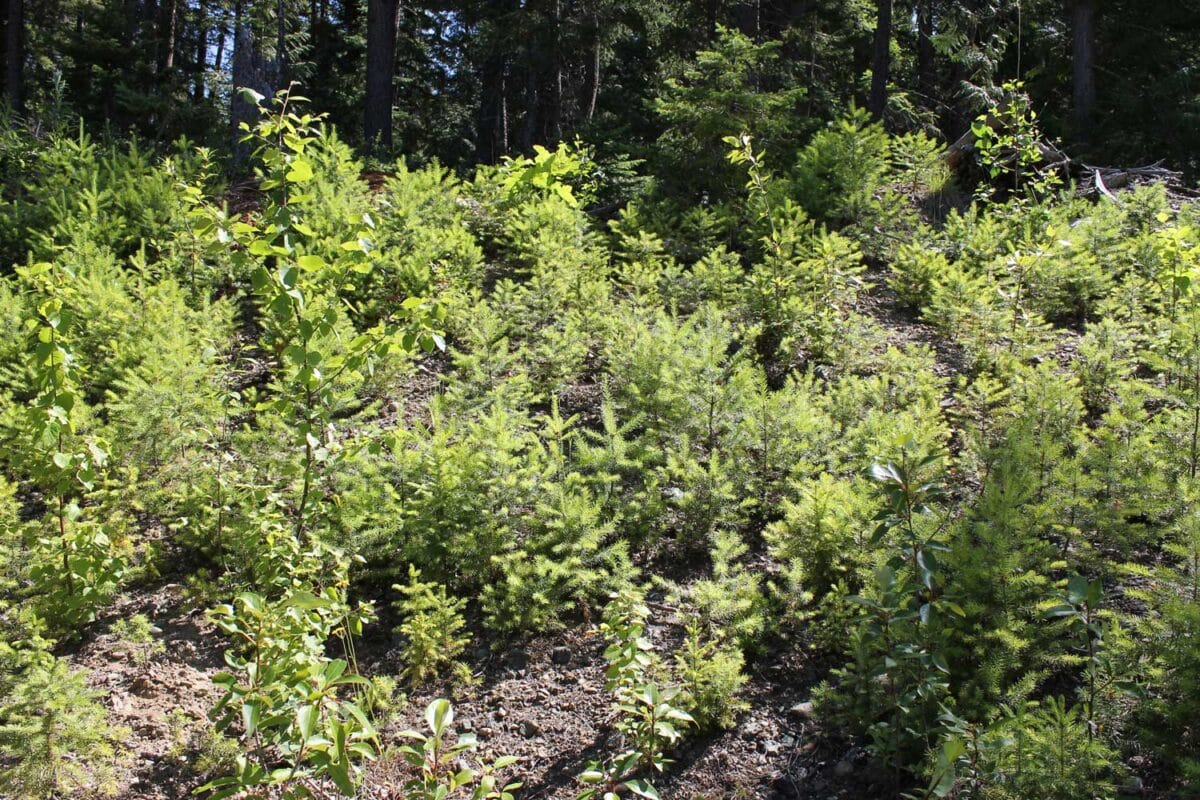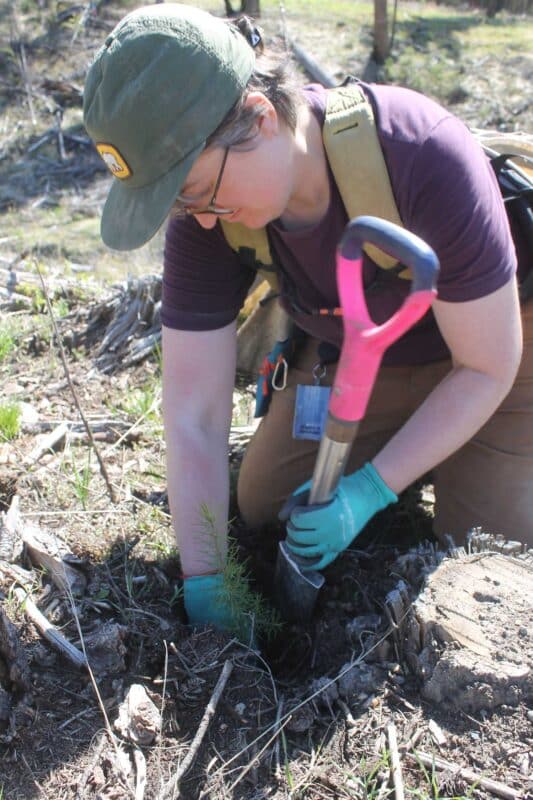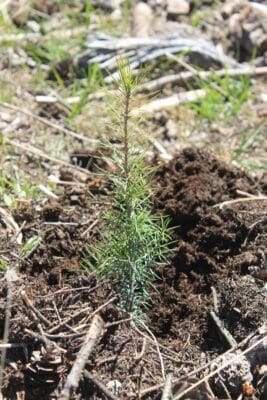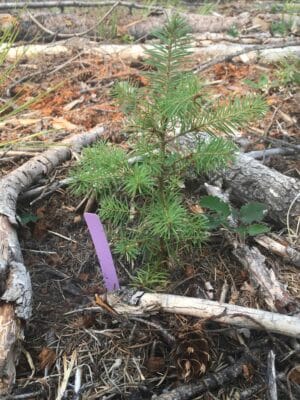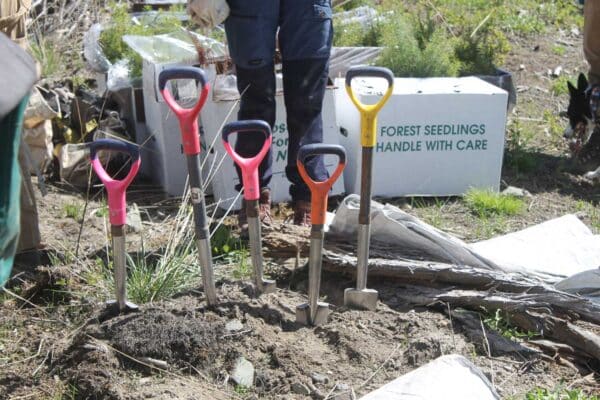Photo credit: Marie Le Bihan
This research brief summarizes research findings from the peer-reviewed article published in January 2025 in the journal Global Change Biology.
From Paper: The interactive role of climatic transfer distance and overstory retention on Douglas-fir seedling survival and height growth in interior British Columbia
Authors: Thomson Harris, Jean Roach, Erin Miller, and Suzanne Simard
The future climatic niche of many conifer tree species is expected to have little overlap with their current species distributions due to climate change. The resulting misalignment of the climatic niche and species distribution is expected to result in forests becoming maladapted in their current location. Interior Douglas-fir (Pseudotsuga menziesii var. glauca) is one such species that is threatened by the changing climate. In Canada, the range of interior Douglas-fir extends from the American border to central British Columbia (B.C.), where it is an ecologically and economically critical species.
B.C. is projected to experience hotter and drier summers and warmer and wetter winters, creating previously undocumented climatic conditions. The climatic niche of interior Douglas-fir is rapidly expanding northwards while contracting in the south. Because of the long maturation period for conifer trees, the range of interior Douglas-fir, like most species, will not be able to migrate quickly enough to match the movement of its climatic niche.
Assisted population migration is the movement of trees – through replanting after forest harvesting – within their natural range to match environmental conditions to which they are currently adapted. This strategy involves identifying tree populations that are suitable to outplant in locations where they will be adapted to the future climate. Introducing populations that are adapted to a projected climate could increase the rate at which local populations adapt to a changing climate faster than they could without assisted migration. The identification of populations and their respective ability to adapt is commonly studied through provenance trials.
Provenance trials involve collection of seed from different areas and planting them in a common location. The aim is to understand the extent to which a species is adapted to local environmental conditions. Moving seed from where it is locally adapted and planting it in a common location creates a “climatic transfer distance” gradient that measures the change in environmental conditions from where the seed was taken to where it is planted. These studies are predominantly done in nursery or clearcut settings. This study is the first to investigate the interactive role of climatic transfer distance and overstory retention on planted interior Douglas-fir seedlings.
In our study, overstory retention is comprised by the spatial distribution of the remaining unharvested trees, and the extent of canopy closure above individual seedlings. The first factor is determined by the silviculture system used when harvesting the stand. A silviculture system integrates specific harvesting, regeneration, and stand tending methods to meet forest management objectives. We applied four silviculture systems: clear-cut (0% retention), seed-tree retention (10% dispersed retention; 25 mature trees retained per ha), 30% aggregate retention (30% of the land base unharvested in 30-40m patches), and 60% aggregate retention with thinning from below (60% of the land base unharvested and uncut areas thinned by removing the smaller trees). Canopy closure is the proportion of the sky above the forest floor covered by a crown of live trees. It is used as an approximation of light availability. Interior Douglas-fir is a partially shade-tolerant species, meaning it can grow under a partially closed canopy.
Our study aimed to determine whether assisted population migration of seedlings can be augmented by careful design of silviculture systems. We examined the individual and interactive effects of climatic transfer distance and silviculture systems on the two-year survival and growth of interior Douglas-fir seedlings using linear models. The response to the climatic transfer gradient was interpreted as a potential response to climate change, and this will allow us to infer how seedlings may respond to the changing climate. For example, moving a seedling to a location with a warmer mean annual temperature is akin to increasing mean annual temperature for the seedlings in situ.
We found that survival was significantly higher, and height was unaffected, in the higher retention treatments when the climatic transfer distance increased frost frequency and decreased humidity. We project that this is because the overstory trees moderate the microclimate that surrounds the seedlings and alleviate harsher climatic conditions they might otherwise be exposed to. In this situation, light availability is not the growth limiting factor; seedlings benefit from an increase in overstory. Conversely, transfers that decreased frost frequency and increased humidity resulted in significantly higher seedling survival in lower retention treatments as the need for more sunlight and less competition was greater than the need for protection from the elements.
Our study also showed that seedlings had better survival and height when they were moved to climates that were warmer, wetter, and more humid than their home climates. This held true for all treatments, although the strength of the relationship changed depending on overstory retention. Moisture availability was a stronger predictor of survival and growth than temperature, indicating that seedlings transferred to warmer yet more arid climates would experience decreased survival and height.
Overstory retention impacts resource availability for new seedlings, which needs to be considered when choosing a silviculture system. Overstory trees can help to create more humid microclimates in ecosystems that are moisture limited by reducing temperatures under the canopy. As the climate changes, seedlings in areas that will face higher drought frequency will benefit from having an overstory to regenerate under. However, in areas where moisture is not a limiting factor, light competition is a more important element for seedling growth. Our findings are particularly important given that the climate is expected to become more arid throughout much of the range of interior Douglas-fir in B.C.
Our study suggests that the early establishment of seedlings can be substantially improved by retaining overstory trees in certain conditions. The use of assisted migration can be complemented by careful selection of silvicultural systems to create more favourable conditions for seedling regeneration. We demonstrate that regenerating forests in a changing climate must be done with an understanding of stand level microclimates within the broader climate of an ecosystem. Forests in B.C. have traditionally been managed under the assumption of a stable climate, but continuing under this assumption risks their future health and productivity. We suggest that as climate changes, maintaining overstory trees will help protect seedlings and assist in early establishment of stands in climates that are expected to experience increased frost frequency and drought.





